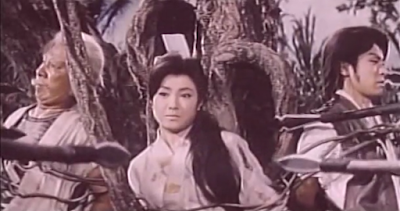A randomly comprehensive survey of extraordinary movie experiences from the art house to the grindhouse, featuring the good, the bad, the ugly, but not the boring or the banal.
Sunday, September 23, 2018
ORBITER 9 (Órbita 9, 2017)
Wednesday, September 12, 2018
SPECIAL MISSION LADY CHAPLIN (1966)
Lady Chaplin is a more stylish film than its predecessor, From the Orient with Fury, but that only makes sense with the greater focus on fashion and sexier women. It's somewhat disappointing to see the formidable Arabella as Zoltan's stooge, but as she finds Agent 077 an insurmountable and attractive antagonist she begins looking out for her own interests, playing all sides off each other to ensure her own survival. This doesn't quite work out, as Zoltan tosses her out of an airplane, but she's prepared for just such a contingency with a parachute and a machine gun to mow down Zoltan's minions on the ground. Malloy is his same old brawling self and gets to have some entertaining fights with a hook-handed henchman of Zoltan, but there are a few too many Goldfinger-inspired electrocutions for comfort this time out, and his bullring battle with a group of gangsters falls far short of the pop-art grandeur of the similarly-set, Coke-fueled combat in Tarzan and the Valley of Gold.
Speaking of Goldfinger, that film's massive success not only made films like Lady Chaplin possible but also persuaded their producers to commission title songs, often with unhappy results. The theme from Special Mission Lady Chaplin isn't quite the gibberish of many a spaghetti western jingle, or as inexcusably awful as many a High Noon-inspired anthem of the 1950s, but it does inflict on memory the regrettably deathless couplet, "Lady Chaplin, in your touch/There is something that means much." That earwig aside, Lady Chaplin is a more expansive and entertaining film than its predecessor. It makes one wish the series had gone on, perhaps with Lady Chaplin reappearing, but when Clark and Grieco teamed up for another spy film a year later, the actor had a new role, leaving it to those dependable Italians to make many more "Agent 077" films with different characters and actors. On the other hand, it may have been for the best for the series to end on this relatively high note.
Saturday, September 8, 2018
Burt Reynolds (1936 - 2018)
In his heyday, Reynolds was more an archetype than an actor. In some ways he was the antithesis of Seventies cinema as we idealize it today. He was an oldschool movie star who, having hit it big, settled into essentially playing himself. But perhaps because he was so popular during that decade, he was tied to it, more so than his peers, in a way that dated him with surprising suddenness. At the time, as his star fell, the moral of the story was that people had tired of seeing him cavort with his cronies on screen. Reynolds was held up as the textbook case of a performer who was having a more entertaining time making his movies than audiences were having watching them. From a greater distance, he seems more like those stars of the roaring 20s who couldn't keep their popularity in the 30s even if they could speak well. Like them, arguably, Reynolds was the victim of an abrupt cultural shift that rendered his persona obsolete. Disregarding the calendar, you can mark the transition from "Seventies" to "Eighties" by the fading of Reynolds' star. Why the Eighties should have excluded him is unclear, unless you see his fall as another repudiation of essentially rustic Americana along the line of the early-seventies purge of hillbilly shows from TV. It probably tells against Reynolds as an actor that, unlike other stars who stumbled around the same time, he never really managed to reinvent his stardom despite numerous opportunities. Perhaps he was meant to be a star only at a certain moment in pop history, but the least you can say about him is that he made the most of his moment.
Sunday, September 2, 2018
KAIZOKU BAHANSEN ("The Pirates," 1960)
Toei spent some money on this film, which deploys several full-scale ships on open water, though they resort to more predictable model work on occasion and many night scenes on board are understandably shot on soundstage interiors. All in all, there's less of a ship-in-a-bottle feel here than in contemporary pirate programmers from the U.S. Sawashima directs energetically, cross cutting and moving his camera closer and closer to the principals to build up momentum for the film's sea battles and keeping his climactic shipboard fight moving at an urgent clip. If anything, his direction is most frantic and over the top in the scenes where the good bahansens return to and depart from their home port. The home folks go nuts for their seafaring heroes, their enthusiasm illustrated by insistently repetitive shots of celebration, from sailors throwing themselves into the water to meet welcoming rowboats to shots of cheering females. The director's galloping camera gives these festive scenes more of an epic feel than anything else in the picture.
In the end it's a simple story of good and evil, but its goodness of purpose is marred by a trip to a primitive island previously ravaged by Uemondayu, populated by badly blackfaced Japanese extras who give the good guys exactly the treatment you might expect from the most racist American movie, short of throwing our heroes into the proverbial stewpot. If you took offense at the Faro Island scenes from King Kong vs. Godzilla, you'd better steer clear of this picture. But if you think you can stomach some unenlightened moments, you'll find Kaizoku Bahansen a pleasant enough adventure film that gets more entertaining as it goes along.











